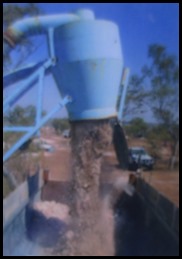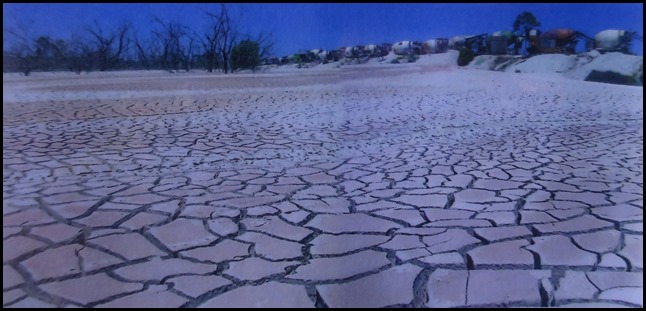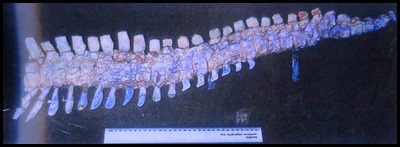Black Hand Tour

Beez Neez now Chy Whella
Big Bear and Pepe Millard
Sat 8 Nov 2014 23:07
|
Chamber of the Black Hand Mine
Tour
 We descended the many
stairs down into the Black Hand Mine and found ourselves in a ‘shop’ that
stretched the length of the first chamber, set up as a jewellers complete with
display cabinets. On the other side lots of information boards and a side room
set up for tea and coffee. Already we were amazed considering five minutes ago
we were up in the heat of day, now in the cool but forty feet down. As we waited
for the others on the tour to pay their entry fees we had a look at some of the
pictures on the wall. The one above, shows the shop
and our first hint that this was to be like no other tour we had ever been
on.
   Once we had paid for our tour Jock our guide led us through a gap and on. From the lower
level art chamber – own blog, looking up. Settled with Jock to listen to the life of an opal
mine.
 We were fascinated to learn how
people actually came and started digging, all very simple. You find an area
measuring fifty by fifty metres, this can be ‘new
ground’ within the dig area. A previously worked area that is now available or
an area that is currently being dug but up for sale. In recent years a safety
course has been introduced and must be attended before you continue in the
process.
Notes:
 Next you go to the
Mine Office and register your area, once the paperwork has been completed
the Office issues a Claim Number,
a map marked with your ‘lot’ and off you
go.
  You take yourself, shovel in one hand,
worksheet in the other and fence off your hole or make a metal grid over your
hole.
Then you follow the worksheet which shows you how to support your shaft. Then you become one
of the hopefuls who give the landscape its unique look. The less successful have
their spade, more luck have digging equipment and the
most successful have sorting gear. Next to the piles of ‘slag’ are various
polite notices informing people that should they touch anything they will
shot............and words to that effect. Some live on site with a variety of
old caravans, converted containers, sheds etc. making the whole area look like
some kind of ‘one careful owner’ in the blistering heat – temperatures here can
hit fifty Centigrade. So this particular adventure is not for the city-dwelling
faint hearts.
Here is an article
called Black Bonanza, Dreams of Fire, this gives a good look into the life of a
miner and opal mining: Opal is Australia’s national gemstone, and black opal
is the rarest and most valuable form, at times reaching carat prices rivalling
those of the best diamonds. The Lightning Ridge area in northwestern New South
Wales produces black opal of the highest quality and much of the world’s supply
of darker opal.
“The Ridge” is
famous for red-on-black gems of superlative brilliance in every conceivable
pattern – harlequin, rolling flash, flower garden, picture stone and Chinese
writing. From the deepest, clearest blues and greens to rippling golden orange,
vermillion, carmine and fuchsia, every colour of the spectrum – glorious and
incandescent – is seen in the best of these stones.
Lightning Ridge
is on the edge of the Australian outback, semidesert country with wide horizons,
huge skies and empty blue-grey bush. The geology consists of low outcrops of
Early Cretaceous sedimentary sandstones overlain by Tertiary gravels and
silicates. Black opal is found at depths of three to thirty metres in
fine-grained Finch claystones, which are freshwater channel deposits laid down
more than one hundred million years ago on a coastal floodplain.
During opal
mining, it is these ancient sediments that are brought to the surface and dumped
as mullock heaps, creating the characteristic moonscape of the Australian opal
fields, blinding in the fierce sun.
Lightning Ridge
earned its name around 1870 when a shepherd, his dog and flock of sheep were
struck by lightning and killed – a portent, perhaps, of times to come when hopes
and dreams were ignited by opal flashes in the dark. A few years after that
shepherd met his demise, opal was found at the ‘Ridge, and opal mining commenced in 1901. In this
unforgiving environment where lack of water is matched by the heat and the dust,
the early miners were tough and fearless, sinking mine shafts through
shinecracker – silicified sandstone, with hammer and chisel. The earliest mining
methods were, of course, the simplest and most arduous, pick and shovel,
windlass and leather bucket. Working by candlelight to find the flashes of red
and often rejecting or ignoring the blue-green stones, the old-timers missed a
great deal of the opal, which they discarded along with sandstone, opal dirt and
gravel. It was piled on the surface around the shaft openings as huge mullock
heaps.
The mullock was
reprocessed in dry rumblers in the 1960’s, a time of mechanical innovation on
the fields. By the 1970’s, inventions such as the automatic self-tipping hoist
and the wet puddler enabled faster extraction and finer processing. After the
late 1970’s, processing and washing were further accelerated by the use of
agitators or converted cement mixing barrels. Open cut mining is used less in
black opal country than in other Australian opal mining areas, but by the late
1970’s, the richest areas of the Ridge were being reworked as open
cuts.
 Ron’s certificate.
These days, opal
mining claims are fifty by fifty metres, and each miner may register up to two
claims. Miners must complete a safety course before registering a claim, and
mine management training has been introduced.
To start mining,
a shaft roughly one metre in diameter is dug down to the level thought to
contain opal.
  Ladders and
lights are secured, machinery is lowered into the shaft and the miner begins
tunnelling. “Drives” and “Ballrooms” are created as the miner searches for opal
along the way. Opal dirt is excavated using jackhammers or machines with names
such as ‘digger’, ‘bogger’ or ‘blower’, many of which are unique to opal mining.
The opal-bearing claystones are brought to the surface by a hoist or blower and
loaded into trucks.
 The Processing Dam. The
settling tank of a processing dam contains tons of silt, which dries in the sun
after being washed in modified cement mixers called “agitators”.
At the processing dams, huge
agitator barrels are perched in rows along massive earth ramps. The Ridge is the
only place on earth where opal dirt is processed in this manner, and the dams
are spectacular and mythic sites. Opal dirt is churned and washed in the
agitators using water from the dams. Because of the limited water supply, this
effort is communal. The process can take many hours, depending on the hardness
of the dirt. The claystone wears down into slurry that is channeled into
settling tanks. Eventually only hard material – sandstone and opal – remains in
the barrel.This residual material is emptied onto sorting trays, hand searched
for opal, then left in heaps that slowly weather back into the
soil.
  Opal is found in seams, sometimes
there are some amazing finds. “Eric” is probably
Australia’s best known fossil that has been preserved in opal. Found in 1987 by
Joe Vida near Coober Pedy in South Australia, Eric is a pliosaur, a marine
reptile closely related to the plesiosaur. He lives as do the other finds in the
Australian Museum. Vertebral section of the “Ken Harris Pleiosaur” found in 1976 in Ken Harris’ opal
mine near White Cliffs, New South Wales.
 
 Opalised jaw
fragments from the early Cretaceous were discovered at Lightning Ridge.
Steropodon galmani found in 1982. Kollikodon
ritchieri under reflected light and transmitted light to show the detail of
preservation.
  Back to our tour. In this particular
mine, the initial hole was dug until it reached a well defined marker between
chalky sediment rock and bedrock. The
opals, if they are there will be found in the layer that my beautiful
assistant is demonstrating. From there test
areas go out like a spiders web – within the claim. It is to be noted
that this mine has yielded $27,000 in twenty five years........
  The current active areas within the
mine. Hardwood poles support the newest dig. The inspection hole seemed to go on for a very long way.
   This mine must cover many claims and
is a smorgasbord of tunnels and workings. When exhausted as a mine this will over time, no
doubt, become extensions to the art galleries.
 A newspaper
clipping showing Ron.
   Just a taste of
what we saw on the art front.
   I had to have a
little rummage, the claystone was cool to the touch and soft and crumbly
like moist chalk. We loved the moving truck but
simply adored the wheelbarrow with its ruddy
extension.
 This is what its all about. The red
fire. Opal.
ALL IN ALL INTERESTING AND
VERY DIFFERENT
SURPRISING AND LIGHT DOWN
THERE |